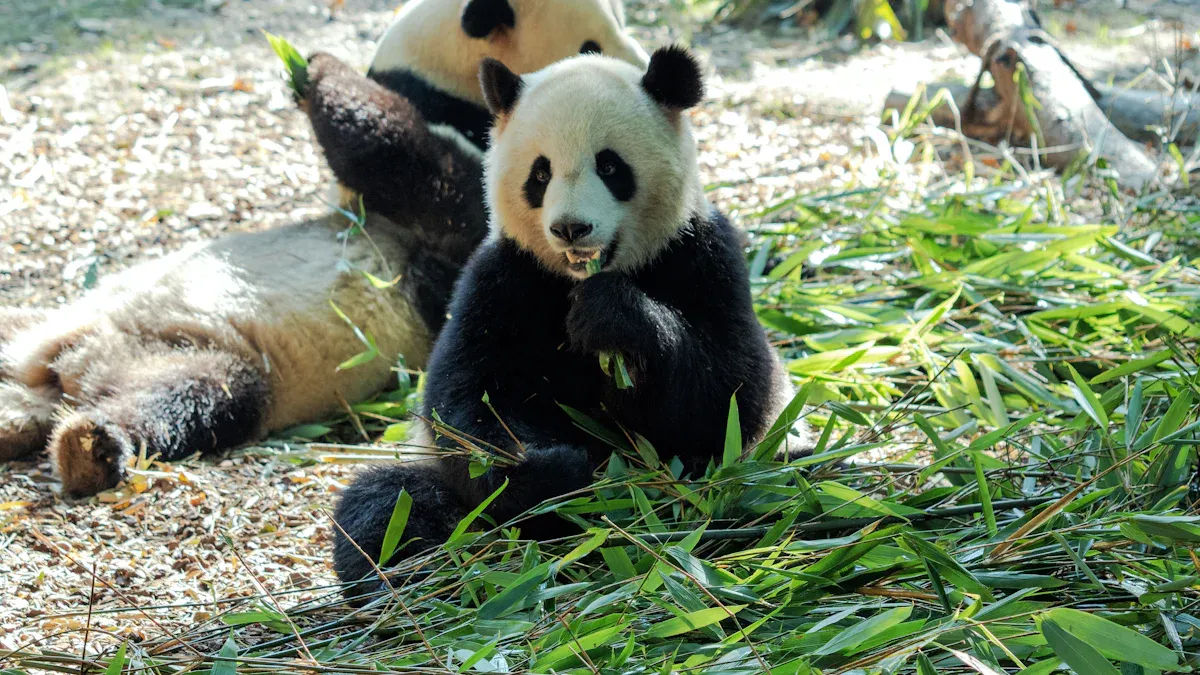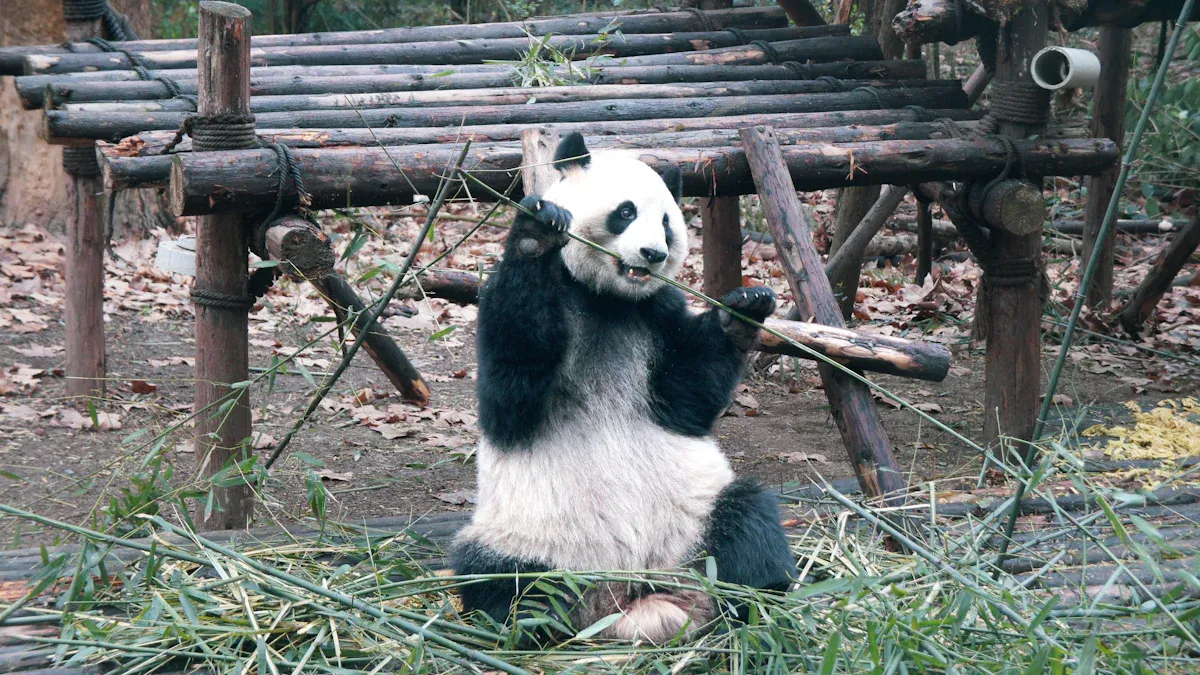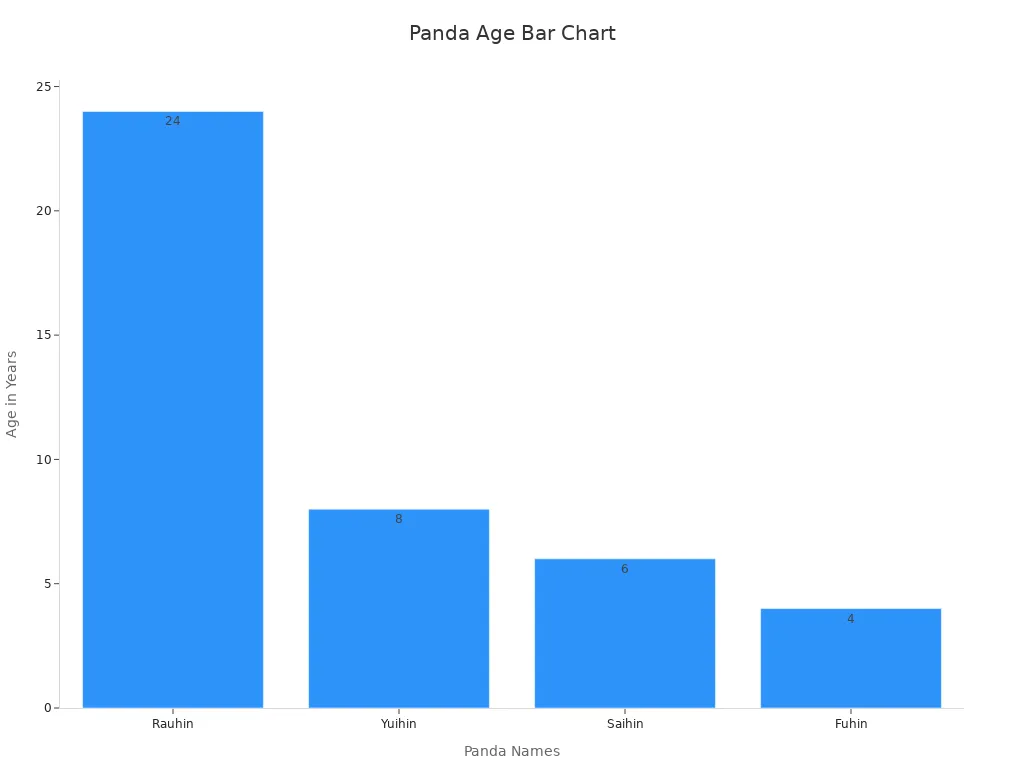Four Giant Pandas will leave Shirahama, Japan, and go back to China this June. This move is part of the worldwide effort to protect this special species.
There are now 1,864 wild Giant Pandas, which is 268 more than before. Conservation work has grown their living areas by 11.8%. Over 66% of wild pandas now live in safe reserves. This success comes from years of teamwork between countries like Japan and China. They have shared ideas, fixed habitats, and worked to save the pandas.
Sending these pandas back shows how teamwork helps protect endangered animals and keep nature healthy worldwide.
Meet the Four Giant Pandas

Names and ages of the pandas
The pandas going back to China are Rauhin, Eimei, Ouhin, and Touhin. Rauhin is the oldest at 23 years old. Eimei, her partner, is 30 years old and one of the oldest male pandas in captivity. Their twin daughters, Ouhin and Touhin, are both 8 years old. These pandas have lived in Japan for years, helping with breeding and conservation programs.
Unique characteristics and notable histories
Each panda has special traits that make them unique. Rauhin is calm and caring, which makes her a great mother. Eimei, being older, is seen as a symbol of strength and long life. Ouhin and Touhin, the twins, are playful and active, often entertaining visitors with their fun behavior.
Giant Pandas are easy to recognize by their black-and-white fur. Their black eye patches and ear markings make them stand out. They have strong jaws and big teeth, perfect for eating bamboo, their favorite food. Their thick fur keeps them warm in China's cool bamboo forests.
In the past, pandas like Ling-Ling and Hsing-Hsing at the Smithsonian's National Zoo became famous for conservation efforts. Though their cubs didn’t survive, their story showed the challenges of panda breeding programs.
Rauhin’s role in breeding programs in Japan
Rauhin has been very important to Japan’s panda breeding work. She was the first panda born at Adventure World in Shirahama and later became a mother. Over time, she has had many cubs, helping grow the global panda population. Her success shows how international conservation programs can work well.
By moving to China, Rauhin and her family will keep helping breeding programs. They will help protect genetic diversity, which is key to pandas’ survival.
Reasons Behind the Pandas' Return
End of the conservation agreement
The four Giant Pandas are going back to China. This ends a long conservation deal between Japan and China. These deals are short-term to help global panda protection. Returning pandas shows both countries care about saving this species.
Why do these agreements have time limits? It’s to balance teamwork and the pandas’ health. In China, experts can care for them in a natural setting. This helps them stay healthy and act like wild pandas.
Importance of breeding and genetic variety
Breeding programs are key to saving Giant Pandas. Genetic variety helps pandas fight diseases and adapt to changes. Some panda groups, like in Qinling, have high inbreeding. Others, like in Qionglai, have less inbreeding, around 28% to 45%. This shows why diverse habitats and careful breeding are important.
When the pandas return, they will join breeding programs. Their babies will help grow a stronger panda population. These efforts protect one of the world’s favorite animals.
Focus on pandas' health and care
The pandas’ health is very important. Experts study their food needs carefully. Different bamboo parts affect their growth and energy:
|
Bamboo Part |
Energy Gained |
Protein Gained |
Growth Rate |
|---|---|---|---|
|
Stalk |
Highest |
Lower |
Lower |
|
Leaves |
Medium |
Lower |
Lower |
|
Shoots |
Medium |
Higher |
Higher |
This research helps caretakers give pandas the best food. Experts also study panda behavior to improve their lives. They work to make breeding and cub care better.
In China, the pandas will get top care and great facilities. Their new home will help them stay healthy and support their species’ survival.
The Pandas' Future in China

Destination: Chengdu Research Base of Giant Panda Breeding
The four pandas will soon live at the Chengdu Research Base. This center, started in 1987, is famous for saving pandas. It began with six pandas and now has over 200. The base keeps temperatures between 59-77°F and humidity at 60%-80%.
Special areas, like mother-care zones and vet clinics, help pandas stay healthy. The base also has spaces to watch how pandas eat and play. A nearby 500-acre bamboo farm provides their food. Each panda eats 20-40 pounds of bamboo daily.
|
Aspect |
Details |
|---|---|
|
Establishment |
Opened in 1987 to protect pandas and their homes. |
|
Initial Population |
Started with six pandas, now has over 200. |
|
Breeding Programs |
Uses artificial insemination and tracks genetic variety. |
|
Environmental Conditions |
Keeps temperatures (59-77°F) and humidity (60%-80%) for comfort. |
|
Specialized Facilities |
Includes mother-care zones and vet clinics for health checks. |
|
Dietary Needs |
Pandas eat 20-40 pounds of bamboo daily from a nearby farm. |
|
Behavioral Observation |
Areas to study how pandas eat and interact socially. |
Plans for their care and breeding opportunities
China has worked on panda breeding since 1955. The first panda born in captivity, Ming Ming, arrived in 1963. New medical tools have made breeding easier and more successful.
"Our program connects wildlife, people, and nature to keep pandas and their homes healthy."
The pandas will help increase genetic variety and solve breeding problems. Female pandas can only mate a few days each year. The Chengdu base uses advanced methods to handle these challenges.
|
Strategy |
Description |
|---|---|
|
Giant Panda Reserves |
Over 67 reserves protect nearly two-thirds of wild pandas. |
|
National Conservation Program |
Protects 3.9 million acres of forests as reserves. |
|
2015-2025 Conservation Strategy |
Works with WWF to create wildlife paths and stronger laws. |
Broader goals for Giant Panda conservation in China
China wants to save panda homes and help them survive. Protected areas now cover 62.39% of panda habitats. About 28.33% of species, including pandas, have full protection.
Efforts also focus on connecting panda habitats. Experts found 14 routes linking key panda areas. These paths help pandas find food and mates. Planting bamboo and thinning stems improve these routes.

China’s work to save pandas also helps protect other animals. By saving forests and building wildlife paths, pandas have a better future.
Impact on Japan
Effect on Japan’s remaining panda population
Sending the four pandas back to China lowers Japan's panda count. With fewer pandas, breeding programs in Japan will face challenges. Pandas are endangered, with about 1,800 in the wild and 500 in zoos. Every panda is important for keeping the species alive.
How does this affect Japan's zoos? Fewer pandas mean fewer chances for breeding programs. Visitors will also have fewer opportunities to see pandas up close. Still, the pandas staying in Japan will help teach people about conservation.
Implications for tourism and local businesses
Pandas are a big draw for zoos like Adventure World. Their playful nature and unique look attract many visitors yearly. With fewer pandas, zoos might see fewer guests. This could hurt nearby businesses like hotels, restaurants, and gift shops.
Shirahama is known for its panda-themed streets and shops. Losing four pandas might bring fewer tourists, affecting the local economy. Zoos can adjust by promoting other animals and educational activities to keep visitors interested.
Reflections on Japan’s contributions to conservation
Japan has done a lot to help save pandas. Zoos like Adventure World have worked on breeding programs and taught people about endangered animals. Rauhin, one of the pandas going back to China, was the first panda born in Japan.
"Visiting Japanese zoos has helped global conservation efforts."
By hosting pandas, Japan has educated millions about wildlife protection. This work will continue, even as the pandas return to China.
Broader Implications of the Transfer
Why this matters for global conservation
The pandas’ return shows how countries can work together. Saving endangered animals like Giant Pandas needs teamwork across nations. This effort proves that protecting wildlife is everyone’s job.
Panda exchanges have always been a sign of unity. For example:
-
Baoxing sent 123 pandas, including 17 to Japan, to help conservation.
-
In 1972, China sent Hsing-Hsing and Ling-Ling to the U.S. after President Nixon’s visit. This act built stronger ties and inspired global teamwork.
These examples show how pandas bring countries together to protect nature.
Building stronger ties between Japan and China
This transfer also brings Japan and China closer. Sharing pandas has helped both countries improve conservation methods. They’ve learned from each other about breeding and saving habitats.
Japan took great care of the pandas. Now, China will continue this work in their natural home. This teamwork sets an example for other countries. It shows how working together can help save endangered animals.
Pandas as symbols of hope
Giant Pandas are more than just animals; they inspire hope. They remind people to care for the planet. Groups like the World Wildlife Fund use the panda as their logo because it stands for saving endangered species.
When people think of pandas, they think of teamwork and hope. The pandas’ move from Japan to China reminds us that saving nature is a global mission.
The return of Rauhin, Eimei, Ouhin, and Touhin to China is a big step for conservation. It shows how important it is to save endangered animals and how teamwork between countries can make a difference.
|
Indicator |
Year |
REI (Effectiveness) |
Notes on Conservation Efforts |
|---|---|---|---|
|
REI |
2000 |
0.044 |
Strong ecological protection |
|
REI |
2015 |
0.031 |
Conservation efforts faced challenges |
|
REI |
2020 |
0.034 |
Small improvement, but still lower overall |
|
Functional Zones |
- |
- |
Zones showed ups and downs |
|
Influencing Factors |
- |
- |
Nature and policies affected conservation |
This table shows the struggles conservation programs face. Still, the pandas' return gives hope for better results in the future.
Japan and China have worked hard to protect pandas and their homes. They’ve shared ideas, improved breeding, and taught others about saving wildlife.
In China, the pandas will live in a safe place. They will help with breeding and inspire people to care for nature. Their story shows that teamwork and effort can help save the planet.








